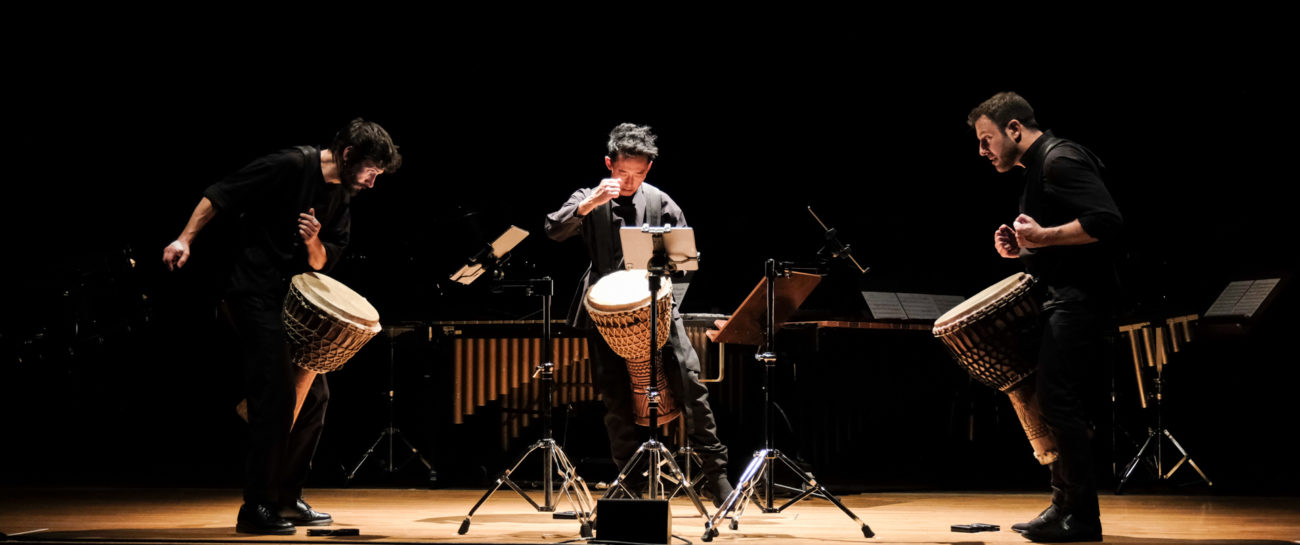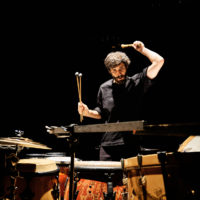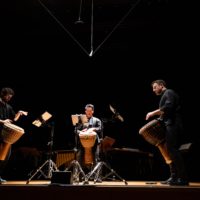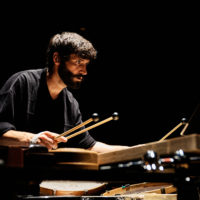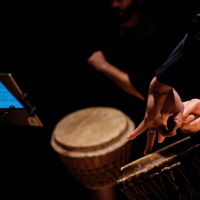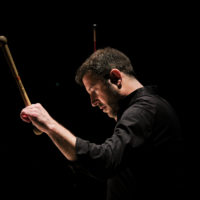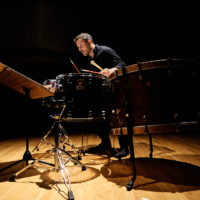Program:
Psappha – for 1 percussionnist (1975) – 12′
by Alexandre Esperet
Rebond A – for 1 percussionnist (1988) – 7′
by Thibaut Weber
Rebond B – for 1 percussionnist (1988) – 6′
by Minh-Tâm Nguyen
Okho – for 3 percussionnists (1989) – 12′
by Alexandre Esperet, Minh-Tâm Nguyen et Thibaut Weber
From the solo (Psappha, Rebonds) to the sextet (Persephassa, Pléiades), the percussion seems emblematic of the great blow struck by Iannis Xenakis at the end of the 1960s to make the rhythmic element, somewhat neglected by the avant-garde, a driving force of the unheard of.”Percussion in itself explains at least three of Xenakis’ major qualities. First of all, his extraordinary curiosity, which led him to open himself to musical cultures from various regions of the world. (…)Second aspect: the rhythm. While contemporary music has been very interested, since the 1930s (Varèse’s Ionisation), in percussion for its variety of timbres, Xenakis has radically innovated by returning, with them, to their primary function, rhythm. (…) Finally, it should be said that the percussion instruments bear witness to one of the major qualities of Xenakis’ music: its gestural character (…). The gestures emanate from the score itself. Listening to Xenakian percussion on record is only half the fun. You have to see them played to realize that the extreme virtuosity they demand from the performer serves a well-ordered succession of gestures, like an ancient rite passed in a hurry, the meaning of which has been lost, and which would now constitute an enigma, a hieroglyph.”
Makis Solomos
PSAPPHA
Commission: Gulbenkian Foundation
Dedicatees: Sylvio Gualda
World Premiere: 2nd of May 1976, UK, London, Round House, by Sylvio Gualda
Publisher: Salabert
Piece for solo percussion, with a large instrumental cast (five groups). But it is not the sound color that Xenakis is interested in, who does not specify the instruments precisely, but only gives indications of texture and register. It is not strictly speaking based on the purely rhythmic work that the composition is based either. No complex values cherished by serial composers or subtle superimpositions of rhythms. The discourse is organized on a regular impulse, even if it varies during the course of the piece, with all parts clearly referring to it.
What the composer does, on the other hand, is a work of varying the density of the different groups, both vertically and horizontally, requiring from the performer a great virutosity, the charm of the music seeming paradoxically to emanate from the sonic and rhythmic asceticism, which gives it an almost incantatory aspect.
It is the woods and skins that open the piece. A first section develops from a dialogue between the medium group, at first dominant, and the high-pitched group with a more lively rhythm, which gradually takes over, but is abruptly interrupted by the low-pitched, very aggressive group. The three groups then seem to balance each other, leading to a section based on a single instrument from each group, violently piercing the silence that has become preponderant. The movement then resumes, integrating the metals, while the discourse uses more and more frequent repetitions and gradually tightens in prolonged rolls. It is then that the lowest instrument emerges, in a regular and sustained beat, with violent and irregular accents, which concludes the piece in force, supported by the high-pitched metals which only appear at this moment.
REBONDS
Dedicatees: Sylvio Gualda
World Premiere: 1st of July 1988, Italy, Roma, Festival Roma Europa, Villa Medicis, by Sylvio Gualda.
Publisher: Salabert
Rebonds is built in two large sections A and B, with no fixed order of play. They use a slightly different instrumentarium: the first one uses only the skins, while the second one introduces in addition the five wood-blocks. Unlike the other works in this program, Rebonds is part of a group of works (Pléiades, Idmen B), where greater rhythmic regularity is asserted.
Part A evolves in an irregular musical structure, resulting in a kind of perpetual movement.
Part B, on the other hand, is characterized by a regular bongo rhythm that is broken by the bass drum with staggered accents, the five wood-blocks interrupting the speech several times in a faster tempo.
With very few exceptions, the nuance is always fff.
The way Xenakis writes for the percussion does not look for solutions in the resonances, it voluntarily limits itself to the impact. As with Varèse, the great forerunner in this field, the use of percussion is one of the many ways Xenaxis uses to get off the beaten track of traditional sound pitches. If a reference had to be chosen in this musical conception, it is less in our civilization but rather in the memory of extra-European music that Xenakis’ work seems to take its root, by its very primitive violence.
Cécile Gilly
OKHO
Dedicatees: Trio Le Cercle
World Premiere: 20th of October 1989, Paris, festival d’Automne, Opéra Comique, by trio Le Cercle (Willy Coquillat, Jean-Pierre Drouet, Gaston Sylvestre) Instrumental set: 3 percussionists
Publisher: Salabert
Composed on the occasion of the bicentenary of the French Revolution, Okho is composed for three musicians playing djembe and and was premiered at the Festival d’Automne in Paris on October 20, 1989. Xenakis’ encounter with the West African djembe took place when he came to the studio of the trio Le Cercle, to which this piece is dedicated. We find in Okho a rare balance between the visceral and the cerebral, creating a kind of tribal modernism. The work is composed of eight sections containing extremely restricted rhythmic material, recombined in solos, duets and trios
ON TOUR:
16th May 2023: Taiwan International Percussion Convention, Taipei, Taïwan
2nd September 2023 : Eleusis 2023 European Capital of Culture in the framework of the Aeschylia Festival, Elefsina, Greece
9th December 2023 : Live @ Home, Apollonia, Strasbourg, France
12th July 2024 : Festival International de Colmar, Eglise Saint-Matthieu, Colmar, France

